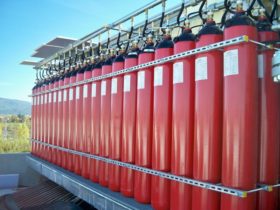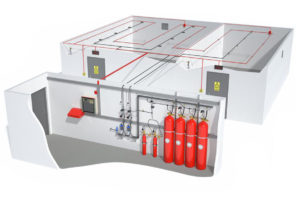Gielle offers all the benefits of inert gas systems with several significant design improvements. You’ll find the inert gas systems solution is safer and more economical than any other system on the market.
Most inert gas systems discharge from the storage cylinders at high pressure, and then use pressure reducers further down the pipe network (therefore requiring both high- and low-pressure piping to handle the pressurized inert gasses as it travels to the discharge nozzles). Gielle inert gas systems is different. Our superior cylinder pressure regulator automatically reduces the pressure of the stored inert gasses at discharge.
We provide an ideal discharge pressure and maintain a constant flow rate throughout the system. That means no need for expensive high-pressure piping. With inert gas systems, you can use small-diameter, low-pressure piping from the storage cylinders/manifold all the way to the nozzles, thus lowering your system costs.
Because of the unique pressure regulated valve assembly, the Gielle inert gas systems agent enters the protected room within the required 60 seconds at a steady flow rate, preventing destructive turbulence from occurring.
Therefore, only the amount of inert gas you really need is discharged, and the necessary venting area is much smaller — you can reduce your installation costs by as much as 60% on venting hardware.
Inert Gas Suppression System Installation
Like any fire suppression system installation, an Inert fire suppression system should only be installed by a specialist fire suppression installation company such as ourselves. Any area to be protected by an Inert gas fire suppression system must be accurately measured to ensure the correct amount of agent is used to sufficiently suppress a fire/potential fire within the specific risk area. This is especially important for inert gas suppression systems such as IG55 systems, IG541 systems and Inergen systems due to the Oxygen reducing properties used to extinguish a fire. We provide complete fire suppression system installation including cylinders, detection, alarm, pipework and interfacing to ‘house-alarm’ system.
The Gielle Fire Suppression System are safe, clean and a natural way to extinguish fire. Gielle offers IG01, IG100, IG55 and IG541 Gasses with all the components needed to configure a complete system for 200/300 bar inert gas extinguishing agent. Full range of cylinders with 67, 80 and 140 litre capacities.
IG01 – 100% Argon
IG100 – 100% Nitrogen
IG55 – 50% Argon+ 50% Nitrogen
IG541- 52% Nitrogen+ 40% Argon+ 8% CO2
Cost-effective multi-zone systems with extinguishing gas storage can be implemented for several extinguishing zones. High degree of flexibility for modification or extension, thanks to the Gielle storage system. Gielle technology enables a more compact storage of the extinguishing agent, requiring up to 50% less space
Fire detection and extinguishing control
Gielle extinguishing systems are controlled and monitored by the fire detection and extinguishing control technology. The extinguishing zones are continuously monitored by smoke, heat and / or flame detectors. These detectors transmit a signal to the fire detection and extinguishing control panel. The panel then activates the Gielle extinguishing system, in the case of multi-zone systems, the relevant selector valve. It triggers an acoustic and optical alarm, which urges anyone in the zone to leave the room affected, and sends a signal to a permanently manned station. Once the individually defined pre-warning time expires, the actual extinguishing process starts. This means that the extinguishing gas is delivered to the extinguishing nozzles thus extruding the oxygen from the source of the fire.
Inert gas fire suppression systems use the full range of extinguishing agents. This makes it easier to fully adjust the design to the needs of our customers. The cylinders may contain: Argon (IG-01), 50% Argon and 50% Nitrogen (IG-55), Nitrogen (IG-100) and 52% Nitrogen + 40% Argon + 8% CO₂ (IG-541). The different characteristics of the areas to be protected are analyzed in detail by our technicians to advise you on the most suitable type of extinguishing system and agent.
Flexibility and Distribution of fire suppression agent
Inert Gas Fire Suppression are ideal for having a single location for central bank cylinder storage facility. This means that fewer cylinders are needed and the installation costs are reduced.
The flexibility of design with Inert gas fire suppression systems allow distribution of INERT gas to multiple voids.
Distribution values are used to direct the gas to where it is required. These valves are either electrically operated or pneumatically operated devices.
Pressure Relief Vents
Pressure relief vents allow the INERT gas to fill the room without inducing too much pressure on the structure of the enclosure.
Due to the lower discharge pressures induced by the inert fire suppression system, this means fewer vents are required.
Inert Gas is a clean agent fire extinguishing system using inert gas (IG55, IG541, IG100 or IG01) and is used in total flooding systems.
Inert Gas has become widely accepted as the best performing, most cost effective, and environmentally friendly inert gaseous suppression system, offering extended hold times and great flexibility in design.
Inert Gas Suppression System Room Integrity Testing
Most Inert gas systems such as Inergen, IG55 and IG541 systems operate as total-flood applications. This means that an Inert System is calculated to work on the provision that the risk enclosure is ‘sealed’ to an acceptable level. Without this assurance of an adequate room seal; no Inert suppression system is guaranteed to operate correctly in a live situation. Each enclosure containing an Inert system should be subject to an annual room integrity test to comply with the relevant standard.
What Is An Inert Gas?
Inert gases are naturally occurring gases. These gases are often used as blends to create a fire suppression suitable agent. Inert gas blends are then used to reduce oxygen to below 15% and above 12% within the protected risk area. Oxygen levels below 15% will not allow a fire to burn as the oxygen is simply not high enough to fuel a fire. Levels of Oxygen between 15% and 12% are adequate to sustain human life. With Oxygen levels between 12% and 10%, a human being will show visible signs of asphyxiation. Oxygen levels below 10% are extremely dangerous, even life-threatening.
Inert Gas is a colorless, odorless, electrically nonconductive gas with a density approximately the same as air. Inert Gas is stored as pressurized gas within the cylinder assembly. When discharged into a protected space, it is clear and does not obscure vision. It leaves no residue and has zero ozone depleting potential and zero global warming potential.
Features and benefits
Suitable for occupied areas
Electrically non – conductive
Chemically inert
Colourless, odourless and flavourless
No residue to clean up after the discharge
Zero Ozone Depletion Potential (ODP)
No greenhouse effect
No global warming impact
No decomposition products
No fog and no loss of post-discharge visibility
Non corrosive/toxic
Stored as a gas
Suitable for occupied areas
Excellent post-discharge visibility
Very low refill cost.
Easy to obtain anywhere in the world
Only agent approved for automatic use in manned environments
In the event of discharge, the agent is cost effective to replace
No evacuation issues
Cylinders can be remote from the risk (up to 100m)
Directional valve solutions to enable mutli-risks to be protected economically using single cylinder bank
Constant flow solution available, therefore reducing size of venting requirement
Large safety margin
Future proof – no risk of being banned
Economical installation costs
Zero Ozone Depletion Potential (ODP)
We simply borrow Nitrogen and Argon from nature. When released, they automatically return to their natural place in the environment.
Zero Global Warming Potential (GWP)
Nitrogen and Argon have no atmospheric lifetime and zero GWP, so they pose no risk to the environment.
Weight Similar To Air
The weight of inert gas agents corresponds closely to that of normal air and will evacuate a protected area slower than halocarbon agents after a discharge.
No Combustion By-Products
Inert gasses do not decompose into toxic or corrosive elements in a fire, making it a safe choice for people and assets.
No Fogging
inert gas systems is ideal for occupied spaces because escape routes remain visible during, and after a discharge.
No Residue
That means no damage to your equipment and no clean up required
Electrically Non-conductive
It is electrically non-conductive and is therefore highly recommended for protecting electrical and electronic materials.
Minimal Thermal Shock
When discharged, inert gasses cause the least amount of thermal shock (sudden temperature drop), compared to other clean agents.

















